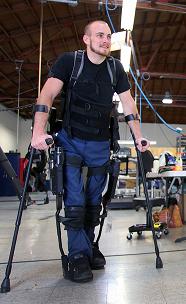Berkeley Bionic’s eLEGS Allow Paraplegics To Walk Again (video)

Share
A whole new generation of paraplegics may be able to stand up and walk away from their wheelchairs. Exoskeleton developers Berkeley Bionics recently unveiled their eLEGS system, a lower body robotic system that allows paralyzed users to stand up and walk on their own. Onboard sensors and artificial intelligence let eLEGS observe gestures in the user's body to know how and when to move the robotic limbs. Patients use crutches to help them move at speeds up to 2 miles per hour. It is powered by battery and can last up to six hours on a charge. Berkeley Bionics plans to start clinical trials for the device early next year with limited commercial release in late 2011. Millions of paraplegics around the world could one day rely on eLEGS instead of wheelchairs for mobility. Check out Berkeley Bionics demonstration of the walking system in the video below. It's pretty amazing to see the looks of joy on patients as they walk on their own legs for the first time in years.
2010 has been a big year for paraplegic technologies. eLEGS is the third paraplegic walking exoskeleton that we've seen in the last six months. It bears a striking resemblance to Argo Medical's ReWalk system, which also uses arm crutches to walk at similar speeds. eLEGS and ReWalk both appear much faster, nimbler, but less stable than Rex Bionic's Rex System out of New Zealand. The Rex will cost around $150k, but neither ReWalk or eLEGS have been firmly priced yet. All three systems look to be competing for the same market. Hopefully that fight will translate into better products and cheaper prices for paraplegics. I'm curious as to whether Berkeley Bionic's announcement this fall, a full year before eLEGS would be available for purchase by patients, is a response in part to the unveiling of ReWalk and Rex.
eLEGS should be accessible to paraplegic people of a variety of sizes. Berkeley Bionics lists the range of heights as 5' 2" to 6' 4" (157 to 193 cm) and maximum weight as 220 lbs (100 kg). The eLEGS system itself weighs just 45 lbs (~20 kg) and supports its own mass when walking. Yet the eLEGS doesn't fully suspend body weight, relying on the operators legs for some support, which should actually have some positive benefits for physical therapy. In the video, one of the testers points out that such partial support will increase circulation, stimulate muscle growth, etc. Deeper knee flexion, another of eLEGS' selling points, should amplify these benefits, as well as open a wider range of terrain that an user can cross. Berkeley Bionics has stated that those patients who adopt the system when it goes on sale in 2011 should not only be able to stand up, sit down, and walk, but also make a variety of turns and even climb stairs. That's all very promising.
Be Part of the Future
Sign up to receive top stories about groundbreaking technologies and visionary thinkers from SingularityHub.


The part of eLEGS that may have the most outstanding potential is also the part that is least clearly demonstrated in the video. I'm very intrigued by the artificial intelligence and gesture recognition programs used by eLEGS to recognize when to move. As medical exoskeletons are improved in the years ahead to become faster and more life like, intelligent control systems will be increasingly important. They might even be the trailing/limiting technology. Understanding how to move without nerve/electrical signals from the body is challenging. The Rex system actually uses joysticks instead. It will be interesting to see if Berkeley Bionics pulls ahead of competitors based on the advantages it has (if they exist) over the control systems of other exoskeletons designed for the paralyzed.
We shouldn't be surprised, I think, of the quality of eLEGS, considering its pedigree. Berkeley Bionics is built off of many of the innovative exoskeleton projects out of the Berkeley Robotics and Human Engineering Laboratory - especially the medical exo they've been working on for years. Berkeley Bionics is also the company which licensed the HULC exoskeleton to Lockheed Martin for use in the US Army. The HULC looks closer and closer to deployment in both military, industrial, and medical applications. In fact, the HULC and eLEGS are very similar systems, as the video points out, and I wouldn't be surprised if developments for the HULC (like load bearing backpacks) eventually made their way to later models of the eLEGS.
This is a very exciting time for prosthetics and walking support systems. Watching the steady pace of progress we've seen in these technologies, a future when robotic limbs will be a common sight on the the streets of the world seems closer everyday. Clearly not every paralyzed person will be able to use exoskeleton technology. The eLEGS, for example, requires patients to be able to self transfer from their chair in order to operate the system. Yet the possibility of walking with robot legs has got to be exciting for the millions of people around the world bound to their wheelchairs. As we improve and refine these exoskeleton systems, the number of patients able to access them will increase. Some day, exoskeletons may surpass wheelchairs as the most common means of mobility for paraplegics. Considering the happiness exuded by eLEGS operators in the video, that will probably be a very joyful day indeed.
[image and video credits: Berkeley Bionics]
[source: Berkeley Bionic Press Release, Berkely Bionics Site]
Related Articles

These Robots Are the Size of Single Cells and Cost Just a Penny Apiece

Hugging Face Says AI Models With Reasoning Use 30x More Energy on Average

Study: AI Chatbots Choose Friends Just Like Humans Do
What we’re reading
